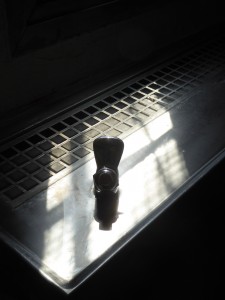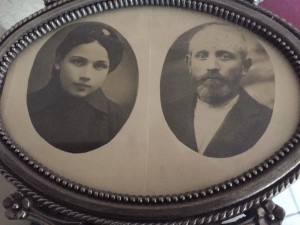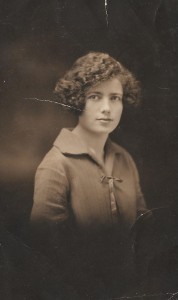Monthly Archives: September 2016
Pondering the Death of “Hangman”

I’ve always prided myself on almost always using games that actually require the students to practice the target language. Take board games, for example. The target language isn’t printed on the board, where the students can memorize what to do / say according to location. The target language is always on cards that we shuffle and change.
But I did play “hangman” with my deaf and hard of hearing students sometimes. My rationale was that slowly filling in each missing letter of the unknown word makes the students really pay attention to the word and what it looks like.
At the ETAI International Conference I attended last July, quite a few speakers brought up the issue of precious time being wasted on activities, including games, where what was really being practiced was not meaningful use of the language. “Hangman” was mentioned as an example.
I’ve been pondering this.

My deaf and hard of hearing students need emphasis on the visual aspect – it would seem that this game makes students look very carefully at the letters that form the word, which helps them commit the word to memory.
But does it actually do that?
I’ll have to admit it doesn’t.
When I look back on the times we’ve played it in class, I think the thing we reviewed most is the alphabet. Some students may have picked up some information about the frequency of letters in a word. But once my high school students discovered what the hidden word was, often after randomly and wildly guessing letters, most of them were not interested in the word itself and the meaning of the word went in one eye and out the other (eyes are better than ears in my classes, remember?). Usage and context wasn’t even a question. The students mainly wanted to know if we have time to guess another word before the bell!
Even if the students chose the words themselves, out of a printed dictionary, they weren’t paying attention to anything other than the length of the word…
So…
I’m relegating this game to the “almost” category I mentioned in the first line of this post. We’re talking about real life after all. Sometimes class dynamics (or teacher exhaustion) requires something light and simple to end a long day for everyone. It least the game is in English…
But I’m NOT Being NITPICKY, Students!

Alternative title – How to lose a teachable moment…
Yesterday we finally got started on creating a “Name Box” in class. Our version of Penny Ur’s recommendation to personalize grammar exercises (see post about that here) got off to a slow start because of two completely different reasons:
- A friendly argument with another teacher about my claim that even though we are NOT following Penny Ur’s advice and using our students’ names, the fact that the students themselves are choosing the names of the famous people included in the box will still have a personalizing effect. Students in special education classes are particularly sensitive and I firmly believe extra precautions are required (I use students’ names when I control the sentences, not a book).
- It turns out that covering a lovely tin (that originally contained BarkTHINS) with sticky red wallpaper is a terrible idea. All the lettering on the box comes through! And then the sellotape (scotch tape) I used to tape pictures on the box over the lettering doesn’t stick well to the wallpaper! I’m still grappling with that problem…
Nevertheless, we began. Eleven students have already chosen their famous person. Along with the person’s name each student had to add the occupation and country (of origin).
I was really pleased that the students were interested in the names of professions and countries in English. The difference between “America” and “American” came up and we looked at how Brazil is really spelled.

But then I ran into trouble. Three students chose names of actors. Great! Except for the fact that they referred to the profession as “players”.
I called everyone’s attention to the fact and tried to explain the difference between a football player and an actor.
The boys in the class thought I was talking nonsense. Why was I inventing a distinction? Why was I being nitpicky?
Not only is the word for both cases exactly the same in Hebrew, those boys play computer /video games and they know about “player one” and “player two”. Actors are just the same. Obviously their teacher doesn’t play enough video games…
At least the girls were more open to the idea of there being a distinction between a player and an actor…
Saturday’s Mystery: Who Were You, Dora? The Father’s Letter

Note: This is a postscript to my Saturday series, in which I, with crowdsourcing help, try to unravel the mysteries hidden in previously unknown letters written by my mysterious step-great aunt Dvora /Dora before and during WWll in Poland. For further explanations see previous post
Translations ascribe meaning.
The trouble is when different people translate the same letter and ascribe different meanings, or at least a different tone to the text.
Among the letter found from Poland (Belarus today) was a letter from Dora’s father, Nachum (Nochim) Meir. The letter is dated April 5th, 1936. It was written to the daughter Libby (in New York) in Yiddish, in very small and difficult to read handwriting, without punctuation marks. It caused difficulties for all who tried to read it. Which only adds to the confusion.
Here are a few examples.

- One version of the translation claims the letter begins: “I am writing you dear daughter but you will not have pleasure from my letter, because I am writing you now to unburden myself, as they say, as I do not have one good friend. This is why I’m writing to you, you will understand me. I am carrying around a bitter heart from everything”. The other versions claim that the father is writing NOT to unburden himself from all the distress and pain in his heart but just so his daughter will understand him.
- The next issue is more conflicted. All five of Nachum Meir’s children from his late first wife fled their childhood home with the terrorizing step-mother, and immigrated. Tales passed down the generations tell of a father who never stood up for his children or noticed that they were being underfed, denied proper clothing for the severe winters and generally mistreated. The question is, did he regret all of that? One version claims he wrote that he feels so bad because he knows he was the worst father in the world. It sounds like a true apology. However, in another translation he sounds like the stereotypical Jewish mother blaming the offspring: “It seems that I am indeed the worst father in the world, as the children do not want to know what I am doing and how I live. Especially since one son and one daughter have children of their own, therefore it should not be like this”.
- All translators agree in regards to the only mention of Hitler in all of these letters – he wishes his poor health and troubles on Hitlers’ followers.

- Another source of conflicting information is in regards to Dora, whose letters we read. All versions agree that the father is asking for money for his sick wife and for Dora’s schooling. On the one hand, from one version of the translation and from Dora’s letters it seems that she is studying in a high-school (Gymnasium): “ …( cut part) Dora another two years in the gymnasium. Her studies will be finished and then she will earn money. She already earns money now, she has some lessons. For the first lesson she took only two dollars (why would he write about dollars??!), then she immediately got another one…I hope she will be able to earn but she must finish the gymnasium in two years.” We do know from Dora’s letters that she graduated in 1938 but she mentions working for money only starting that year. She doesn’t say doing what. A different version of the translation claims that money is needed to pay the tutor who teaches Dora so that she can graduate. No Dora tutoring anyone. Perhaps “pay the tutor” is the same as paying the school?
Was he a contrite father writing for help or did he feel unjustly treated by his fleeing offspring? I want to believe the former because of this sentence (only one translator figured it out): “In life you always make mistakes and the world is such that you always hurry and you run and you stop for nothing and die like a fool”.
I guess I’ll never know.
Very sad, no matter how you look at it.
Saturday’s Book: “Blue” by Lou Aronica

How do I tell you about this book without spoiling it for you? I want you to enjoy it too!
I started it in the best possible way – I read the first few pages, got totally hooked and didn’t want to stop. I knew nothing about the book and that worked out really well. Reviews I have seen since completing the book include spoilers! Don’t read the plot online!
I can say that its a young adult book (you can tell) . I generally like young adult books but am usually good at predicting events in them. In this book I was often surprised.
The author thanks Ray Bradbury in the forward. I actually think the book has elements that remind me of “The Never Ending Story” & “The Fault in our Stars”. And yes, there is a part where you will probably be glad if a tissue box is nearby.
The color blue is important here.
There are some bits in the beginning which are slightly confusing but otherwise its a very engaging read, a really moving story with parts that I simply could not stop reading. I finished it quite quickly! I just had to know how it would turn out.
I really would like to believe in the ending…